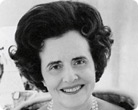Mary Lasker was a powerful and tireless philanthropist and citizen lobbyist who advocated for increased funding for medical research. Also renowned for her work in urban beautification, Lasker made significant contributions to the landscaping of New York and Washington, D.C.
Lasker was born Mary Woodard in Wisconsin in 1900; her father was a banker and her mother was the founder of two local parks. After suffering frequent ear infections as a child, she resolved to forward medical research when she grew up, but she didn't realize that goal immediately. In 1923, she graduated from Radcliffe College and then studied briefly at Oxford. She moved to New York City where she began working at the Reinhardt Galleries and building an art collection, which included works by Renoir and Miró. In 1926, she married the gallery's owner, Paul Reinhardt; the marriage ended in divorce eight years later.
After leaving the art world, she married Albert Davis Lasker, the owner of Lord and Thomas advertising agency, in 1940. Together, they founded the Lasker Foundation in 1942, with the mission to support medical research and health programs. Even after the deaths of its founders (Albert died in 1952 of cancer), the foundation continues to recognize significant new research with the Lasker Award and many of the honorees have gone on to win the Nobel Prize.
Lasker served formally on the boards of the American Cancer Society, Research to Prevent Blindness, and the Cancer Research Institute. But perhaps her most potent efforts were behind-the-scenes as a citizen lobbyist, persuading city, state, and federal officials to provide for funds for medical research on major diseases. She often had the ear of the president and was a particularly close friend of the Johnson administration. Her efforts pushed Congress to increase appropriations for the National Institutes of Health and to establish additional research centers focusing on specific diseases, such as the National Cancer Institute. In 1969, she was awarded the Presidential Medal of Freedom and two years later, became the driving force behind the National Cancer Act, which made cancer research a national priority. She even sold most of her art collection, because, she said, "I wanted to be able to give the money away." As she noted in 1985, "Without money, nothing gets done."
Her childhood love of parks and gardens fed her other great interest–beautifying urban spaces. Thanks to Lasker, three hundred donated cherry trees blossom every spring at the United Nations and lighted Christmas trees decorate Park Avenue every winter. She also funded flower plantings at many other locations around New York and Washington, D.C.
Lasker also served on the boards of the Museum for Modern Art, the Norton Simon Museum, and New York University. She received the Congressional Medal of Honor in 1989. Mary Lasker donated her papers and two extensive oral-history interviews to Columbia University, one in 1965 and one in 1982. She died in 1994, at age 93.















